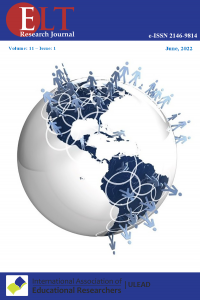Öz
Kaynakça
- Allwright, R. L. (1975), ‘Problems in the study of the language teachers treatment of learner error’. In Marina K. Burt and Heidi C. Dulay, New Direction in Second Language Learning, Teaching and Bilingual Education. (Ed.) pp.96-109. Washington D.C.: TESOL.
- Allwright, R.L. & Bailey, K.M. (1991). Focus on the language classroom: an introduction to classroom research for language teachers. Cambridge: Cambridge University Press.
- Burt M. & Kiparsky, C. (1972), The Gooficonn: A repair manual for English. Rowley Massachusetts: Newburg House.
- Chan, A. E., Day, R. R., Chenoweth, N. A. & Luppescue, S. (1982). Errors, interaction, and correction: A study of native-non-native conversations. TESOL Quarterly, 16, 537-547.
- Chastain, K. (1971). The development of modern language skills: Theory to practice. Philadelphia: Center for Curriculum Development, Inc.
- Corder, S. P. (1973). Introducing applied linguistics. Harmondsworth: Penguin.
- Corder, S. P. (1982). Error analysis and interlanguage. Oxford University Press.
- Ellis, R. (1990). Instructed second language acquisition: Learning in the classroom. Cambridge MA: Basil Blackwell.
- Ellis, R. (1997). Second language acquisition. Oxford: Oxford University Press.
- Erdoğan, V. (2005). Contribution of error analysis to foreign language teaching. Mersin University Journal of the Faculty of Education, 1(2), 261-270.
- Hendrickson, J. M. (1978). Error correction in foreign language teaching: Recent theory, research and practice. Modern Language Journal, 62, 378-398.
- James, C. (1998). Errors in language learning and use: Exploring error analysis. Longman: London and New York.
- Lennon, P. (1991). Error: Some problems of definition, identification and distinction. Applied Linguistics, 12(2), 96-180.
- Levelt, W.J.M. (1983). Monitoring and self-repair in speech. Cognition, 14, 41-104.
- Richards, J. C., Platt, J., & Platt, H. (1992). Dictionary of language teaching and applied linguistics. Essex: Longman.
- Shahin, N. (2011). Error treatment in TESOL classrooms. J. J. Appl. Sci.: Humanities Series 13 (1), 207-226.
- Touchie, H. Y. (1986). Second language learning errors: Their types, causes and treatment. JALT Journal, 8(1), 75-80.
Öz
This study aims to analyze the relationship between the students’ grammar achievement and types and frequency of errors they make in grammar course. The relevant data were gathered from an EFL class at a state university in Turkey by means of two sources; students' average scores of 3 midterm exams and audio recordings. The analysis of the data revealed that the students mostly made phonological errors followed by grammatical errors consisting of syntactic and morphological errors. According to the results, high achievers tended to have more errors while low achievers tended to have fewer errors supporting the claim that errors are an indication of learning. However, it is difficult to infer a direct relation between these variables. The analysis of the data also indicated that there might be other factors affecting the frequency and types of errors such as number of the turns that students take, students’ personality traits, their willingness to participate and to take risks for testing their knowledge. The findings of this study also offer some suggestions for further studies on errors in language classrooms.
Anahtar Kelimeler
Types of errors frequency of errors grammar achievement grammar courses EFL learners
Kaynakça
- Allwright, R. L. (1975), ‘Problems in the study of the language teachers treatment of learner error’. In Marina K. Burt and Heidi C. Dulay, New Direction in Second Language Learning, Teaching and Bilingual Education. (Ed.) pp.96-109. Washington D.C.: TESOL.
- Allwright, R.L. & Bailey, K.M. (1991). Focus on the language classroom: an introduction to classroom research for language teachers. Cambridge: Cambridge University Press.
- Burt M. & Kiparsky, C. (1972), The Gooficonn: A repair manual for English. Rowley Massachusetts: Newburg House.
- Chan, A. E., Day, R. R., Chenoweth, N. A. & Luppescue, S. (1982). Errors, interaction, and correction: A study of native-non-native conversations. TESOL Quarterly, 16, 537-547.
- Chastain, K. (1971). The development of modern language skills: Theory to practice. Philadelphia: Center for Curriculum Development, Inc.
- Corder, S. P. (1973). Introducing applied linguistics. Harmondsworth: Penguin.
- Corder, S. P. (1982). Error analysis and interlanguage. Oxford University Press.
- Ellis, R. (1990). Instructed second language acquisition: Learning in the classroom. Cambridge MA: Basil Blackwell.
- Ellis, R. (1997). Second language acquisition. Oxford: Oxford University Press.
- Erdoğan, V. (2005). Contribution of error analysis to foreign language teaching. Mersin University Journal of the Faculty of Education, 1(2), 261-270.
- Hendrickson, J. M. (1978). Error correction in foreign language teaching: Recent theory, research and practice. Modern Language Journal, 62, 378-398.
- James, C. (1998). Errors in language learning and use: Exploring error analysis. Longman: London and New York.
- Lennon, P. (1991). Error: Some problems of definition, identification and distinction. Applied Linguistics, 12(2), 96-180.
- Levelt, W.J.M. (1983). Monitoring and self-repair in speech. Cognition, 14, 41-104.
- Richards, J. C., Platt, J., & Platt, H. (1992). Dictionary of language teaching and applied linguistics. Essex: Longman.
- Shahin, N. (2011). Error treatment in TESOL classrooms. J. J. Appl. Sci.: Humanities Series 13 (1), 207-226.
- Touchie, H. Y. (1986). Second language learning errors: Their types, causes and treatment. JALT Journal, 8(1), 75-80.
Ayrıntılar
| Birincil Dil | İngilizce |
|---|---|
| Konular | Dil Çalışmaları |
| Bölüm | Research Article |
| Yazarlar | |
| Yayımlanma Tarihi | 30 Haziran 2022 |
| Gönderilme Tarihi | 29 Mart 2021 |
| Yayımlandığı Sayı | Yıl 2022 Cilt: 11 Sayı: 1 |


